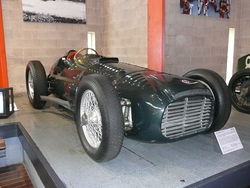BRM P30
 |
|||||||||
| Category |
Formula One Formule Libre |
||||||||
|---|---|---|---|---|---|---|---|---|---|
| Constructor | British Racing Motors | ||||||||
| Designer(s) | Peter Berthon | ||||||||
| Technical specifications | |||||||||
| Chassis | Steel box-section ladder. | ||||||||
| Suspension (front) | Porsche-type trailing arms, with Lockheed oleo struts. | ||||||||
| Suspension (rear) | de Dion tube, with Lockheed air struts. | ||||||||
| Axle track | F: 52 in (132.1 cm) R: 51 in (129.5 cm) |
||||||||
| Wheelbase | 104 in (264.2 cm) | ||||||||
| Engine | BRM 1,496 cc (91.3 cu in) V16 supercharged, front-mounted. | ||||||||
| Transmission | BRM 5-speed, transverse shaft. ZF differential. | ||||||||
| Weight | 1,624 lb (736.6 kg) (Unladen) | ||||||||
| Fuel | Petrol/alcohol mix. | ||||||||
| Tyres | Dunlop. | ||||||||
| Competition history | |||||||||
| Notable entrants |
BRM Ltd. Owen Racing Organisation |
||||||||
| Notable drivers |
|
||||||||
| Debut | 1950 BRDC International Trophy | ||||||||
|
|||||||||
| n.b. Unless otherwise stated, all data refer to Formula One World Championship Grands Prix only. |
|||||||||
The BRM Type 15 was a Formula One racing car of the early 1950s, and the first car produced by British Racing Motors. The car was fitted with a revolutionary supercharged 1.5-litre V16 engine which produced considerably more power than any of its contemporaries.
The distinctive noise of the car made it a favourite with crowds wherever it appeared, but the initial unreliability of the car, its inability to live up to the hype that the project's leading figures had created around it, and the change to Formula Two regulations in 1952 meant the project never achieved the hoped-for level of success on the Grand Prix stage.
After the end of the Second World War motor racing slowly returned, based on whatever machinery could be found, largely consisting of the pre-war Voiturette cars conforming to a formula of supercharged 1.5-litre engines. One of the more successful voiturette constructors of the late 1930s had been English Racing Automobiles, founded by Raymond Mays and others. Mays was a very patriotic British driver with an enviable reputation, but despite considerable success in lesser races he had been given little opportunity to race in Grands Prix, since there were very few significant British attempts to build suitable cars to challenge the dominant Italian and later German cars. In early 1939, ERA's wealthy backer Humphrey Cook withdrew his funding, and Mays along with talented and imaginative ERA engineer Peter Berthon founded Automobile Developments Ltd, a project to build a fully-fledged British Grand Prix car along the lines of Mercedes-Benz and Auto Union. Throughout the war, the idea gestated in the two men's minds, with Berthon latching on to the idea of a supercharged 135° V16 engine as had been proposed to power the British Union Grand Prix car. With the end of the war in sight, Mays began to look for backers within British industry for his project.
Designers Peter Berthon and Eric Richter were expecting 500 bhp and at least 12,000rpm from their new British Racing Motors V16 engine, which was a 1.5-litre 135° V16 designed to meet the 1947 "Formula A" regulations that would go on to become Formula One in 1950. A V8 configuration had also been considered but it has been suggested that the V16 was chosen in part to bolster the car's image when approaching potential sponsors.
...
Wikipedia
